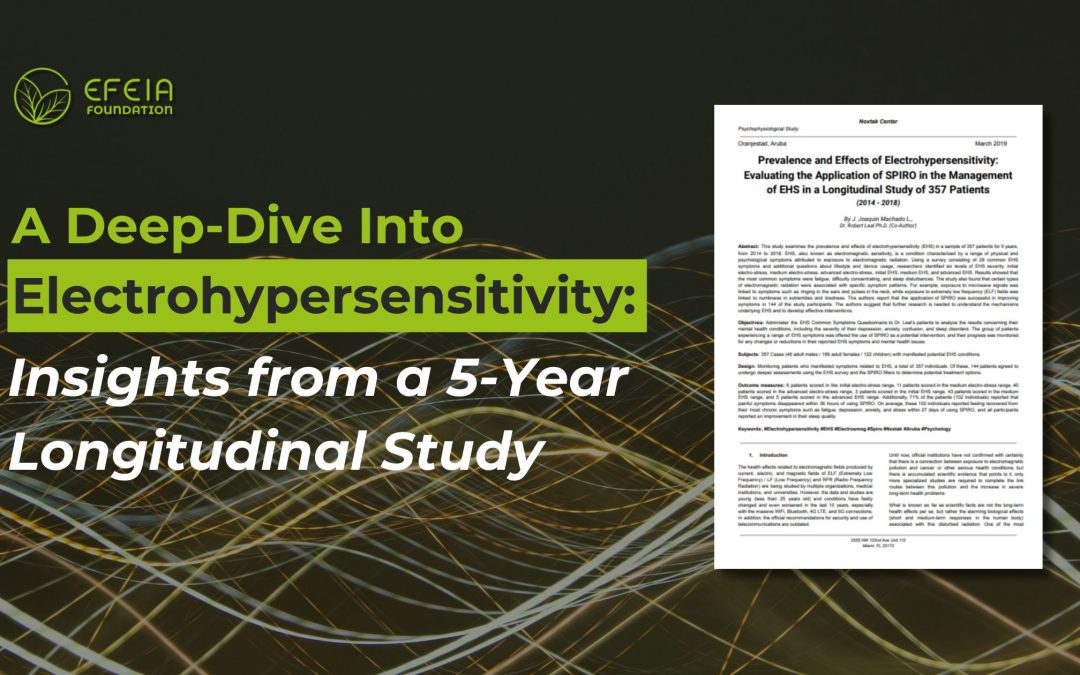In a world increasingly saturated with wireless technology, electromagnetic fields (EMFs) have become an unavoidable part of our environment. While the convenience of these technologies is undeniable, a growing body of research suggests that EMF exposure may be associated with adverse health effects in some individuals.
A 5-year longitudinal study conducted by the NOXTAK Center in collaboration with Dr. Robert Leal, Ph.D., offers compelling insights into the phenomenon known as electrohypersensitivity (EHS) and potential approaches for managing its symptoms.
The NOXTAK Center Study: A Comprehensive Approach
From 2014 to 2018, researchers monitored 357 patients (46 adult males, 189 adult females, and 122 children) who exhibited symptoms potentially associated with electromagnetic field exposure. The study utilized the EHS Common Symptoms Questionnaire, a comprehensive assessment tool that evaluates 29 symptoms commonly reported by individuals with EHS.
What makes this research particularly valuable is its long-term approach. Unlike single-point assessments, this longitudinal study provided researchers with the opportunity to track symptom progression, assess the effectiveness of interventions, and identify patterns that might otherwise go unnoticed in shorter studies.
Defining Electrohypersensitivity
Electrohypersensitivity (EHS) is not recognized as a medical diagnosis in most countries. However, the World Health Organization (WHO) has acknowledged it as “a phenomenon where individuals experience adverse health effects while using or being in the vicinity of devices emanating electric, magnetic, or electromagnetic fields.”
Dr. Olle Johansson, a pioneer in EHS research, approaches the condition differently, describing it not as a medical condition but as a functional impairment in which the environment is the culprit for any temporal or permanent loss or abnormality of physiological, mental, or anatomical function. In Sweden, EHS is recognized as such a functional impairment, shifting the focus from treating the individual to addressing the environment.
The Study’s Findings
The researchers identified six levels of EHS severity based on participants’ responses to the questionnaire:
- Initial electro-stress
- Medium electro-stress
- Advanced electro-stress
- Initial EHS
- Medium EHS
- Advanced EHS
Among the 144 patients who received deeper assessment, the distribution across these categories revealed that advanced electro-stress (40 patients) and medium EHS (43 patients) were the most common classifications.
The most frequently reported symptoms included fatigue, difficulty concentrating, and sleep disturbances. Interestingly, the study found that certain types of electromagnetic radiation were associated with specific symptom patterns. For example, exposure to microwave signals was linked to symptoms such as ringing in the ears and pulses in the neck, while exposure to extremely low frequency (ELF) fields was associated with numbness in extremities and general fatigue.
The SPIRO Intervention
Perhaps the most striking finding of the study was the response to the SPIRO (Spin Radiation Organizer) technology developed by the NOXTAK Center. Of the 144 patients who opted to try this intervention, 71% (102 individuals) reported that their painful symptoms disappeared within an average of 36 hours after beginning to use SPIRO.
Furthermore, these individuals reported feeling recovered from their most chronic symptoms such as fatigue, depression, anxiety, and stress within an average of 27 days of using SPIRO. All participants in this group also reported improvements in sleep quality, a critical factor in overall health and well-being.
The researchers noted that patients who followed the recommended dietary, vitamin, hydration, and lifestyle changes along with SPIRO usage experienced shorter recovery times compared to those who didn’t implement these additional recommendations.
The Nocebo Effect Consideration
The researchers were careful to consider the potential influence of the nocebo effect—negative outcomes produced by negative expectations—in their study. They identified eight cases of severe EHS where individuals continued to experience adverse reactions when exposed to sources of EMF pollution even after implementing protective measures.
After careful analysis, the researchers determined that these individuals were experiencing a nocebo effect triggered by seeing or knowing about potentially harmful technologies. This finding underscores the complex interplay between physiological and psychological factors in EHS and highlights the importance of addressing both in treatment approaches.
Implications for Public Health
This longitudinal study provides valuable insights into the prevalence, effects, and potential management of electrohypersensitivity. The findings suggest that EHS is a real phenomenon affecting a significant portion of the population, with symptoms that can substantially impact quality of life.
The success of the SPIRO technology in alleviating symptoms in a majority of study participants offers hope for those affected by EHS. However, the researchers emphasize the importance of a comprehensive approach that addresses not only EMF exposure but also nutrition, hydration, supplementation, and lifestyle factors.
As our technological landscape continues to evolve with the proliferation of 5G networks, smart homes, and wearable devices, understanding the potential health implications of electromagnetic fields becomes increasingly crucial. Studies like this contribute to our knowledge base and may inform future public health guidelines and interventions.
Join the EHS Global Census
If you experience unexplained symptoms such as fatigue, headaches, sleep disturbances, or difficulty concentrating, the Electropollution Free Environment International Accreditation (EFEIA) Foundation invites you to participate in their EHS Global Census project. This worldwide initiative aims to identify and support individuals affected by Electrohypersensitivity while gathering crucial data to advance scientific understanding of this condition.
EFEIA’s mission is to set and uphold the highest standards for reducing human and environmental exposure to electromagnetic pollution. Through the Global Census, they work to quantify the prevalence of EHS worldwide, identify common symptoms and triggers, evaluate high-risk demographics, and ultimately support advocacy for better recognition and accommodations.
By participating in our specialized surveys—including the 25 Common EHS Symptoms Test, Multiple Habits and Sensitivities assessment, Sleep Disorders evaluation, and Differential Diagnosis of Electrohypersensitivity—you contribute to a growing body of evidence that can inform public policies, support research, and help create electromagnetically hygienic environments.
Your participation is not only an opportunity to assess your own potential sensitivity but also a chance to add your voice to a global movement advocating for safer electromagnetic environments. As we continue to advance technologically, balancing innovation with health considerations will be essential, and the EFEIA Foundation’s work represents a critical step toward understanding and addressing the impact of our increasingly electromagnetic world.

